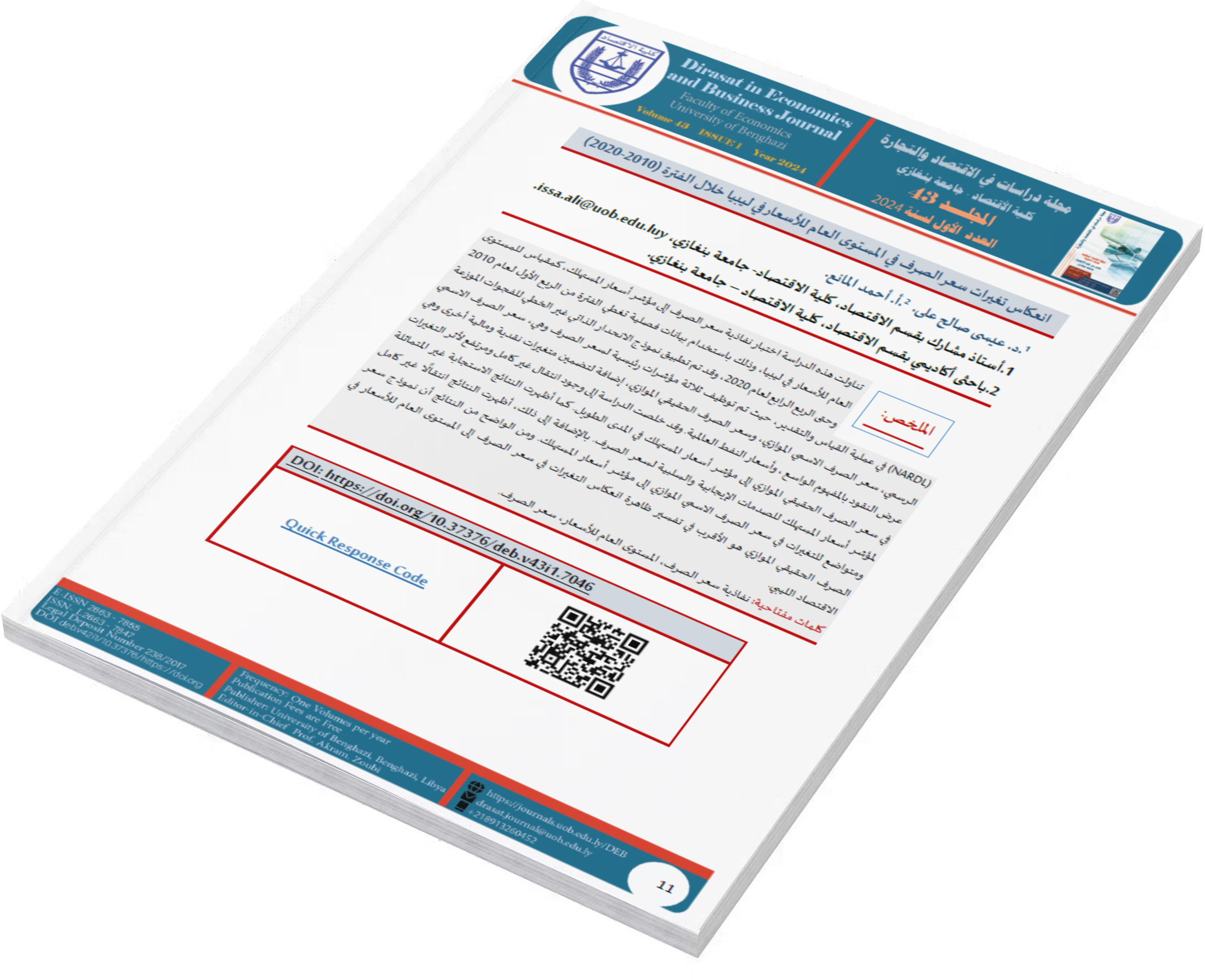انعكاس تغيرات سعر الصرف في المستوى العام للأسعار في ليبيا خلال الفترة (2010-2020)
DOI:
https://doi.org/10.37376/deb.v43i1.7046الكلمات المفتاحية:
نفاذية سعر الصرف، المستوى العام للأسعار، سعر الصرفالملخص
تناولت هذه الدراسة اختبار نفاذية سعر الصرف إلى مؤشر أسعار المستهلك، كمقياس للمستوى العام للأسعار في ليبيا، وذلك باستخدام بيانات فصلية تغطي الفترة من الربع الأول لعام 2010 وحتى الربع الرابع لعام 2020، وقد تم تطبيق نموذج الانحدار الذاتي غير الخطي للفجوات الموزعة (NARDL) في عملية القياس والتقدير، حيث تم توظيف ثلاثة مؤشرات رئيسية لسعر الصرف وهي، سعر الصرف الاسمي الرسمي، سعر الصرف الاسمي الموازي، وسعر الصرف الحقيقي الموازي، إضافة لتضمين متغيرات نقدية ومالية أخرى وهي عرض النقود بالمفهوم الواسع ، وأسعار النفط العالمية. وقد خلصت الدراسة إلى وجود انتقال غير كامل ومرتفع لأثر التغيرات في سعر الصرف الحقيقي الموازي إلى مؤشر أسعار المستهلك في المدى الطويل. كما أظهرت النتائج الاستجابة غير المتماثلة لمؤشر أسعار المستهلك للصدمات الإيجابية والسلبية لسعر الصرف. بالإضافة إلى ذلك، أظهرت النتائج انتقالًا غير كامل ومتواضع للتغيرات في سعر الصرف الاسمي الموازي إلى مؤشر أسعار المستهلك. ومن الواضح من النتائج أن نموذج سعر الصرف الحقيقي الموازي هو الأقرب في تفسير ظاهرة انعكاس التغيرات في سعر الصرف إلى المستوى العام للأسعار في الاقتصاد الليبي
التنزيلات
المراجع
- Adekunle, W., & Ajao, T. (2018). Exchange Rate Pass-through to Consumer Prices in Nigeria: An asymmetric approach (MPRA Paper No. 88797). University Library of Munich, Germany.
- Al Samara, M., Moons, C., & Van Hove, J. (2013). Exchange rate pass-through: evidence from the Syrian economy. International Economics and Economic Policy, 10, 405-425.
- Alkhareif, R. M., Albakr, A. B., & Alsayaary, S. S. (2016). Exchange Rates Pass-Through in Saudi Arabia. Saudi Arabian Monetary Agency. Working paper, 16, 2.
- Bache, I. W. (2002). Empirical modelling of Norwegian import prices (No. 2002/1). Working Paper.Norges Bank, Oslo.
- Banerjee, A., Dolado, J., & Mestre, R. (1998). Error‐correction mechanism tests for cointegration in a single‐equation framework. Journal of time series analysis, 19(3), 267-283.
- Barhoumi, K. (2006). Differences in long run exchange rate pass-through into import prices in developing countries: An empirical investigation. Economic Modelling, 23(6), 926-951.
- Beirne, J. (2010). International exchange rate dynamics and purchasing power parity (Doctoral dissertation, Brunel University).
- Beirne, J., & Bijsterbosch, M. (2011). Exchange rate pass-through in central and eastern European EU Member States. Journal of Policy Modeling, 33(2), 241-254.
- Brun-Aguerre, R., Fuertes, A. M., & Greenwood-Nimmo, M. (2017). Heads I win; tails you lose: asymmetry in exchange rate pass-through into import prices. Journal of the Royal Statistical Society. Series A (Statistics in Society), 587-612.
- Campa, J. M., & Goldberg, L. S. (2005). Exchange rate pass-through into import prices. Review of Economics and Statistics, 87(4), 679-690.
- Delatte, A. L., & López-Villavicencio, A. (2012). Asymmetric exchange rate pass-through: Evidence from major countries. Journal of Macroeconomics, 34(3), 833-844.
- Feinberg, R. M. (1986). The interaction of foreign exchange and market power effects on German domestic prices. The Journal of Industrial Economics, 61-70.
- Fisher, E. (1989). Exchange rate pass-through and the relative concentration of German and Japanese manufacturing industries. Economics Letters, 31(1), 81-85.
- Helmy, O., Fayed, M., & Hussien, K. (2018). Exchange rate pass-through to inflation in Egypt: a structural VAR approach. Review of Economics and political science, 3(2), 2-19.
- Ho, S. H., & Hafrad, I. (2020). Asymmetric exchange rates pass-through: New evidence from Vietnam. Online at https://mpra.ub.uni-muenchen.de/98651/ MPRA Paper No. 98651.
- Karaoğlu, N., & Demirel, B. (2021). Asymmetric Exchange Rate Pass-Through into Inflation in Turkey: A NARDL Approach. Fiscaoeconomia, 5(3), 845-861.
- Karoro, T. D., Aziakpono, M. J., & Cattaneo, N. (2009). Exchange rate pass‐through to import prices in South Africa: is there asymmetry? 1. South African Journal of Economics, 77(3), 380-398.
- Kassi, D. F., Sun, G., Ding, N., Rathnayake, D. N., & Assamoi, G. R. (2019). Asymmetry in exchange rate pass-through to consumer prices: Evidence from emerging and developing Asian countries. Economic Analysis and Policy, 62, 357-372.
- Krugman, P. R., Obstfeld, M., & Melitz, M. (2018). International Finance: Theory and Policy. Pearson Higher Ed.
- Laflèche, T. (1997). The impact of exchange rate movements on consumer prices. Bank of Canada review, 1996(Winter), 21-32.
- McCarthy, J. (2000), Pass through of exchange rates import prices to domestic inflation in some industrialized economies, Eastern Economic Journal, Vol. 33 No. 4, 511-537.
- McCarthy, J. (2007). Pass-through of exchange rates and import prices to domestic inflation in some industrialized economies. Eastern Economic Journal, 33(4), 511-537.
- Mohammed, K. S., Bendob, A., Djediden, L., & Mebsout, H. (2015). Exchange rate pass-through in Algeria. Mediterranean Journal of Social Sciences, 6(2), 195.
- Mumtaz, H., Oomen, O., & Wang, J. (2006). Exchange rate pass-through into UK import prices.Bank of England Working Paper No. 312, Available at SSRN: https://ssrn.com/abstract=965463 or http://dx.doi.org/10.2139/ssrn.965463
- Mwase, N. (2006). An empirical investigation of the exchange rate pass-through to inflation in Tanzania. https://www.elibrary.imf.org/view/journals/001/2006/150/article-A001-en.xml
- Naz, F., Mohsin, A., & Zaman, K. (2012). RETRACTED: Exchange rate pass-through in to inflation: New insights in to the cointegration relationship from Pakistan. Economic Modelling, 29(6): 2205-2221.
- Pesaran, M. H., Shin, Y., & Smith, R. J. (2001). Bounds testing approaches to the analysis of level relationships. Journal of applied econometrics, 16(3), 289-326.
- Rahimov, V., Jafarova, N., & Ganbarov, F. (2017). The exchange rate pass-through to CPI and its components in oil-Exporting CIS countries (No. HEIDWP06-2017). Graduate Institute of International and Development Studies Working Paper.
- Savoie-Chabot, L., & Khan, M. (2015). Exchange rate pass-through to consumer prices: Theory and recent evidence (No. 2015-9). Bank of Canada Discussion Paper.
- Shin, Y., Yu, B., & Greenwood-Nimmo, M. (2014). Modelling asymmetric cointegration and dynamic multipliers in a nonlinear ARDL framework. Festschrift in honor of Peter Schmidt: Econometric methods and applications, 281-314.
- Taylor, J. B. (2000). Low inflation, pass-through, and the pricing power of firms. European economic review, 44(7), 1389-1408.

التنزيلات
منشور
كيفية الاقتباس
إصدار
القسم
الرخصة

هذا العمل مرخص بموجب Creative Commons Attribution-NonCommercial-NoDerivatives 4.0 International License.







